CLIMATE-CHANGE IMPLICATIONS FOR DRYLANDS AND FARMING COMMUNITIESClimate Change and Dryland SystemsC.T. Simmons and H. D. MatthewsPlant Genetic Resources and Climate Change: Stakeholder Perspectives from the Nordic and Arctic RegionsS.Ø. Solberg, A. Diederichsen, Á. Helgadóttir, S. Dalmannsdóttir, R. Djurhuus, A. Frederiksen, G. Poulsen, and F. YndgaardAdaptation of Farmers to Climate Change: A Systems Approach to Cereal Production in Benslimane Region, MoroccoS.B. Alaoui, A.M. Adan, Y. Imani, and O. LahlouAssessment of the Demand–Supply Match for Agricultural Innovations in AfricaL. Woltering, L. Bachmann, T.O. Apina, B. Letty, J.A. Nyemba, and S.B. AlaouiPOTENTIAL OF USING GENETIC RESOURCES AND BIODIVERSITY TO ADAPT TO AND MITIGATE CLIMATE CHANGEExploitation of Genetic Resources to Sustain Agriculture in the Face of Climate Change with Special Reference to WheatArdeshir B. Damania, A. Morgounov, and C.O. QualsetUtilizing the Diversity of Wild Soybeans in China for Accelerating Soybean Breeding in the Genome EraY. Li, R. Chang, and L. QiuAdaptation of Potato (Solanum tuberosum) and Tomato (S. lycopersicum) to Climate ChangeR. SchafleitnerBarley Genetic Resources for Climate-Change Adaptation: Searching for Heat-Tolerant Traits through Rapid Evaluation of SubsetsA. Jilal, H. Ouabbou, and M. MaatouguiFruit Genetic Resources Facing Increasing Climate UncertaintyO. Saddoud Debbabi, S. Mnasri, S. Ben Abedelaali, and M. MarsAPPLIED MATHEMATICS (UNLOCKING THE POTENTIAL OF MATHEMATICAL CONCEPTUAL FRAMEWORKS)Applied Mathematics in Genetic Resources: Toward a Synergistic Approach Combining Innovations with Theoretical AspectsA. Bari, Y.P. Chaubey, M.J. Sillanpää, F.L. Stoddard, A.B. Damania, S.B. Alaoui, and M. MackayPower Transformations: Application for Symmetrizing the Distribution of Sample Coefficient of Variation from Inverse Gaussian PopulationsY.P. Chaubey, A. Sarker, and M. SinghToward More Effective Discovery and Deployment of Novel Plant Genetic Variation: Reflection and Future DirectionsM.C. Mackay, K.A. Street, and L.T. HickeyIdentifying Climate Patterns during the Crop-Growing Cycle from 30 Years of CIMMYT Elite Spring Wheat International Yield TrialsZ. Kehel, J. Crossa, and M. ReynoldsAssessing Plant Genetic Resources for Climate-Change Adaptive Traits: Heat TraitsA. Bari, M. Inagaki, M. Nachit, A.B. Damania, H. Ouabbou, M. Karrou, C. Biradar, and B. HumeidPlant Genetic Diversity: Statistical Methods for Analyzing Distribution and Diversity of SpeciesM. Singh, A.B. Damania, and Y.P. ChaubeyAPPLIED OMICS TECHNOLOGIESExploiting Germplasm Resources for Climate-Change Adaptation in Faba BeanF.L. Stoddard, H. Khazaei, and K.Y. BelachewDeveloping Climate-Change Adaptive Crops to Sustain Agriculture in Dryland Systems through Applied Mathematics and GenomicsS. Dayanandan and A. BariToward the Rapid Domestication of Perennial Grains: Developing Genetic and Genomic Resources for Intermediate WheatgrassT. Kantarski, L. DeHaan, J. Poland, and J. BorevitzTraits for Testing, Screening, and Improving Salt Tolerance of Durum Wheat Genetic ResourcesR. Chaabane, A. Saidi, M.S. Moufida, S. Chaabane, S. Sayouri, M. Rouissi, A. Ben Naceur, M. Inagaki, H. Bchini, M. Ben Naceur, I. Ayadi, and A. BariGene Flow as a Source of Adaptation of Durum Wheat to Changing Conditions Including Climate Change: Double Gradient Selection TechniqueM. Nachit, J. Motawaj, Z. Kehel, D. Habash, I. Elouafi, M. Pagnotta, E. Porceddu, A. Bari, A. Amri, O.F. Mamlouk, and M. El BouhssiniAddressing Diversity of Ethiopian Durum Wheat Landrace Populations Using Microsatellite MarkersA.G. Tessema, G.G. Venderamin, and E. Porceddu











